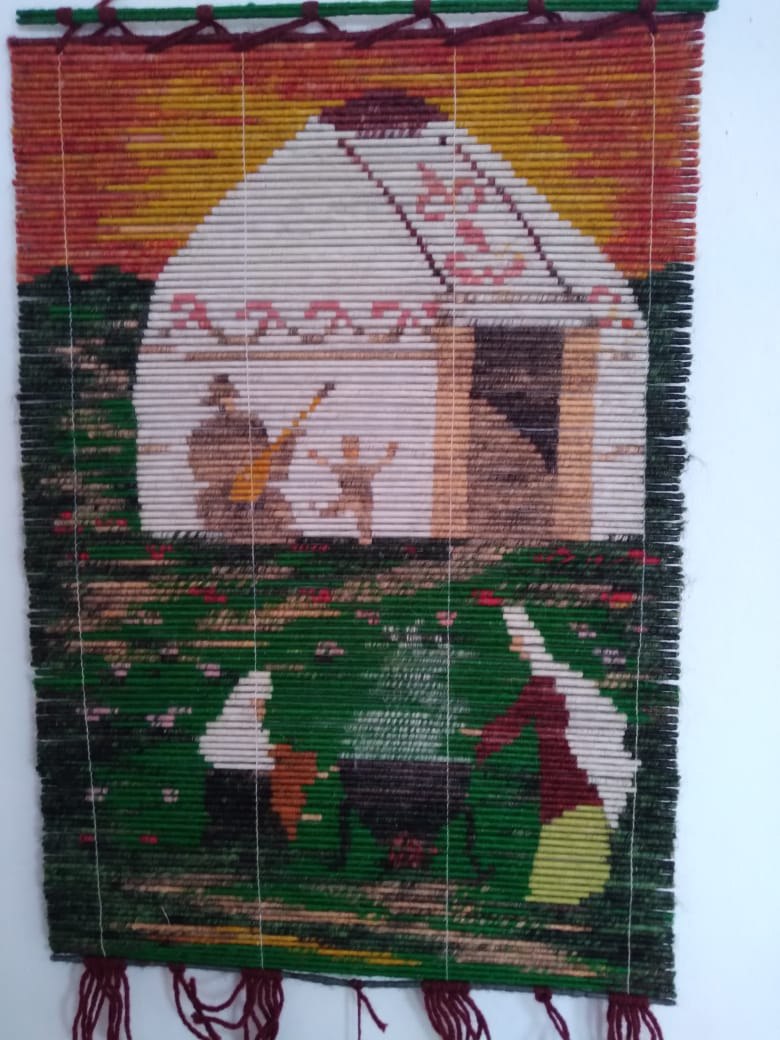
Chee – the art of mat weaving
To make a mat requires a fairly simple machine, on which the constituent parts of the mat, namely shi stems, are fastened by throwing twisted woolen yarns over them, the balls of which are wound on small stones for weighting in the manner of sinker. This machine is a simple device: two upright logs are dug into the ground, connected at the top with a beam, on which 5 to 10 threads with a sinker are thrown.
There are two types of mats – aq shi and orauly (orama) shi. Aq shi comes in several types, which are divided into the following by their purpose: öre shi (simple woven shi stems, a mat used for drying dairy products – kūrt and irimshik), shabaq shi (a large mat used for making felt) and shym shi (a simple unzipped mat).
The Kazakhs in Mongolia still have a saying: “Shi orauly bolmasa, üidin säni kelmeydi. Qyzyl, jasil kimese, qyzdyn säni kelmeydi” which means “The house is ugly if the mat is not patterned and the girl is not pretty if she does not wear red and green clothes”.
Traditional shi products were made in bright colours, predominantly geometric designs. By winding wool on shi plants’ reeds and thus collecting various ornamental compositions from multi-coloured elements, artisans created unique decorative mats. The technology of preparing the material is also labour-intensive. First it is dried and cleaned, and only then the mats are woven from it. The most difficult part of mat weaving is creating the pattern, where the dominant role is played by ornamental composition, which is constructed of symmetrically built patterns.
During shym shi mat making, cleaned and trimmed stems were laid tightly on a flat surface, after which the craftswoman poked a pattern with a thick needle or awl, sometimes using a red-hot rod for this purpose. Sometimes masters tied knots in a necessary place of the outline of the pattern, making peculiar marks for orientation when creating a pattern, when the woman wrapped stems with the prepared wool. Wool in this case, skilled worker held the wool in her left hand, and the right at the same time rotated the stem to the yarn evenly and tightly laid on the stem. The shym shi pattern was formed as the stems were attached to each other.
Depending on the complexity and size of shym shi mats, it took from a few hours to a few days to make them. It should be borne in mind that in former times women kept all patterns in memory.
In some parts of Kazakhstan, women are still making patterned mats. However, there are few of them now. Aigul Razakova, the leader and ideological inspirer of “Aynalayin” Public Association (Zhambyl region), is particularly remarkable among traditional craftswomen. In her village, the craftswoman opened a summer camp, where she teaches children and adults various women’s crafts, from making shym shi to qūraq.
Art historian and artist Natalia Bazhenova notes that, unfortunately, every year traditional patterned shym shi mats, like many other types of Kazakhstani applied arts, are increasingly becoming museum pieces.
However, according to a specialist there are some positive trends: traditions of Kazakh national applied art have greatly influenced the creativity of modern masters. Natalia Bazhenova herself works in shym shi technique.
Zliha Kalenderova, a master of applied arts of shym shi from the village of Zhideliaryk in Shiyeli District, is one of the folk craftswomen. She runs an applied art circle at the local school, but she has visitors not only from children but also from adults. She herself performs portraits, landscapes and other subjects in this technique.
Astana artists, Aliya Kanibekova, is engaged in the revival of the art of chee weaving. She is a member of the Union of Artists of Kazakhstan and creates art works using the techniques of shi, tapestry, felting, etc. She teaches children and conducts master classes for adults.
Aklia Saduakasova, a unique craftswoman, lives in Semey, where she not only weaves chee using traditional technology but also masters the art of making black soap from fathen.
The shi technique has also attracted the attention of renowned artists in Kazakhstan. For instance, major works by renowned artist Raikul Akhmetjanova are made in traditional Kazakh art technique of shi weaving. This artist, using shi stems together with wood, felt or ceramics, combines ancient techniques and creates new compositional elements, which give three-dimensional space forms to her works.
Another artist who draws inspiration from traditional materials and techniques is Kulyash Akasheva. Her stylised compositions “Summer” and “The Firebird” are based on shi mat technology. The artist has dedicated almost all her life to preserving, studying and reviving Kazakh crafts. In the 1990s she established the “Terme” production plant, which created traditional costumes on a
professional basis.
Chee has permanently attracted the attention of the Kazakhstani masters Alibai and Saule Bapanov, who are renowned in Kazakhstan and far beyond. The creative duo of masters has managed to create a whole new trend in contemporary
art, a synthesis of avant-garde and folklore. Raushan Bazarbaeva, a well-known artist of decorative arts, has a special approach to chee. In her works, it appears systematically, emphasizing the lyricism of the images in her works.
Another master of arts and crafts, Aliya Kanibekova, is engaged in batiс, felt-making, shym shi mats, fabric painting and leather crafts, teaching her skills to children and young people for more than 25 years. Young masters also turn to the technique, such as Meruert Naymanova, who creates original compositions on folk subjects.
Thus, the traditional shym shi technique continues to live on in the work of modern masters, but in a new format. However, the traditional technique itself must be carefully preserved and passed on to new generations of masters.




